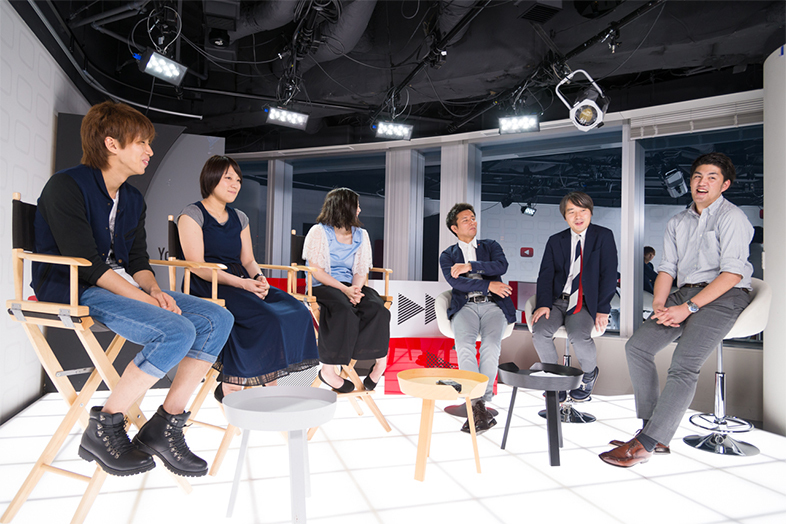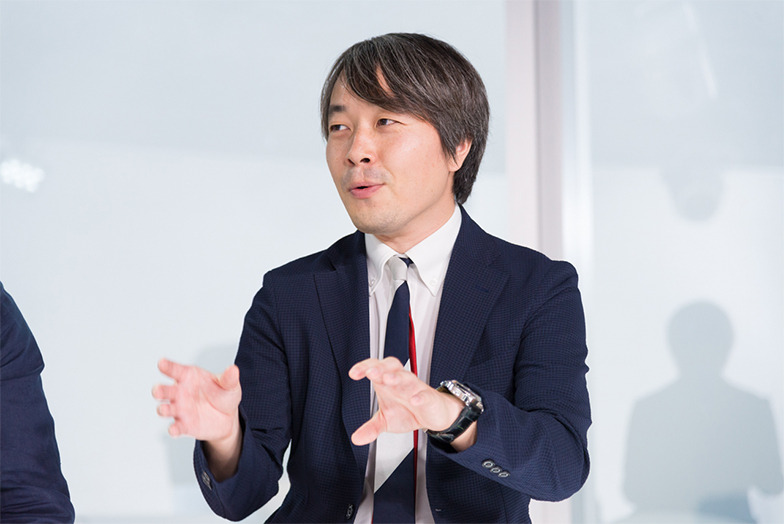On a certain day in July, people from various backgrounds who engage with YouTube held a discussion at YouTube Space Tokyo in the city.
In the first session, six participants— Hajime Shacho, a YouTuber gaining significant attention recently; the Japanese Elektel Union; Yasushi Hasegawa, YouTube Product Marketing Manager at Google; Yukita Higashihata, CM Planner at Dentsu Inc.; and Naoto Ikegami, responsible for Google alliance operations at Dentsu Inc.—explored content creation for online video, focusing primarily on the perspectives of these two groups. Moving forward, the discussion will focus on how to weave the essence of online video, as represented by YouTube, into marketing activities.
Can Buzz Happen in Advertising Too?
Ikegami: Not just YouTubers, but companies are also creating content on YouTube to convey their messages. From that perspective, how do you think YouTube should be utilized?
Hasegawa: It depends on the case, but YouTubers who post frequently tend to gain a certain level of viewer recognition through repeated trial and error. For companies, it's difficult to match the posting frequency of YouTubers like the second group who upload daily. However, through trial and error, they can gradually grasp what viewers are seeking.
When creating videos, the best approach is to get content out there and find solutions along the way. In that sense, including the know-how accumulated so far, YouTubers' efforts often provide valuable reference points for content creation in corporate marketing activities.
Ikegami: What are your thoughts on this, Mr. Higashihata, whose main battlefield is TV commercials?
Higashihata: The reality is that trial and error hasn't really taken root in TV commercials yet. But listening to both of you, I strongly feel you're making an important point. Corporate TV commercials and videos are produced with substantial budgets, yet uploading them to YouTube sometimes yields limited viewership. This is precisely where perseverance and trial-and-error become essential. Perhaps we should even consider setting production budgets and schedules that inherently account for trial-and-error.
A similar phenomenon occurs in the gaming industry: on smartphones, social games with simplified visuals and rules often outperform elaborate, story-driven AAA titles. I believe YouTubers achieve astonishing view counts because they intuitively grasp, through trial and error, how changing viewing environments alter content demands.
Furthermore, on YouTube, even advertisements are perceived as a form of content. This environment, where viewers choose what they want to watch from a vast array of content, differs significantly from TV commercials that aggressively seek to capture attention. In this sense, clients seem to be acutely aware that they must cultivate a sense of creating something people actually want to seek out.
Hasegawa: To illustrate how the barrier between "content" and "advertising" is lowering, consider this: four of the top ten trending YouTube videos in the US last year were "ads."
More companies are achieving astonishing view counts and becoming topics of conversation with videos created under the constraints of advertising. What these four videos share in common, just like the two works we have here, is that they possess elements that spread socially – such as unexpected twists or pleasantly subverting viewer expectations – while also effectively fulfilling their role as corporate communication. YouTube anticipates more such ads in the future.
Higashihata: As I mentioned earlier, I also sense a shift in mindset through my daily interactions with clients. For example, one company positions the videos they regularly upload to YouTube as "gift movies," requesting content primarily focused on making consumers want to watch—whether it's simply funny or emotionally moving. Budget allocation is also shifting. Companies are actively allocating significant budgets to web-based creative content like YouTube, aiming to create videos that viewers will seek out. The goal is to strengthen brand loyalty as a result.
YouTubers are media, not creators
Ikegami: Trial and error, including posting frequency, seems like one key factor. Beyond that, when creating content, is there anything you consciously focus on specifically because it's YouTube?
Japan Elektel Union: We're happy when many people watch, but since it's a collection of individuals, we focus on the single person sitting in front of their smartphone or computer screen. It's like a politician's campaign—we consciously aim for "you watching YouTube" to feel that they are one of those view counts.
Ikegami: That's exactly what YouTube's name implies—programs made just for you. Hajime-san, you create videos through collaborations with companies. Is there anything you consciously focus on in those cases?
Hajime Shacho (hereafter Hajime): Even when approached for tie-up projects, I make sure to actually use the product and find its merits from my own perspective. Also, I'm really into stationery, so when I get a project for mechanical pencils, I get super excited. When it's something I genuinely like, that enthusiasm really comes through to the viewers. As a result, people say, "I bought it too!" or "Me too!"...
Hasegawa: One key point for companies when collaborating with YouTubers on product introduction videos is ensuring the YouTuber's audience aligns with the customer base they want to reach. In Hajime-san's case, it matched well with students and others who choose and buy their own stationery. Plus, reviewing familiar products made for entertaining and useful videos.
Hajime: Also, this isn't really a comparison, but if a company made a video of someone taking a cola bath versus me making one, I think mine would get more views. Even if they spend a lot of money, it ends up feeling kind of TV-like, or stiff. Maybe it's because when I do the same thing, people feel a different, more relatable connection compared to a company doing it.
Hasegawa: Hajime Shacho's videos get around 100 million views in a month during peak times. To put that in perspective, that's on par with the channels of top-tier domestic record labels. However, those record label channels combine the view counts of multiple top artists' music videos. In that sense, even videos made by a group of companies combined don't get as many views as a video Hajime makes alone in his apartment.
Higashihata: I get that feeling. What exactly is that? I want to know too.
Ikegami: First, we need to acknowledge that reality, that fact. That said, as mentioned earlier, the U.S. reality is that 4 out of the top 10 videos in rankings are corporate-produced. That could change in Japan too.
Hasegawa: Yes. In that sense, I believe the two groups we have with us today are the kind of entities that can shift the mindset of companies and marketers.
Higashihata: We need to distinguish between the role of YouTube as a platform and the role of "YouTubers as a platform." It might be better to differentiate between deploying branded content from companies on YouTube and treating YouTubers themselves as a platform to create touchpoints between companies and users.
Hasegawa: Exactly. We can differentiate their use, and we can also create content inspired by works made by YouTubers.
In online video marketing, it's crucial to view YouTubers not just as creators, but also as media with strong fan engagement.
In the next installment concluding this discussion, we'll continue exploring YouTube-driven marketing and the nature of consumer communication we can learn from YouTubers, examining it from diverse perspectives including YouTubers, CM planners, and platform operators.
※Part 1: "The Web Video Rules Only YouTubers Know"
※Part 3: "How YouTubers Reveal the Secrets to Being Loved by Fans"












